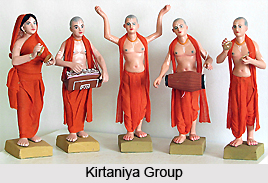 Kirtaniya is actually a form of Maithili theatre that prevailed in Mithila and north Bihar. The word Kirtaniya is derived from `kirtan`. Kirtaniya is performed in a group and the troupe is generally called jamati. The team comprises of hero, heroine, female friends, clown, and an orchestra.
Kirtaniya is actually a form of Maithili theatre that prevailed in Mithila and north Bihar. The word Kirtaniya is derived from `kirtan`. Kirtaniya is performed in a group and the troupe is generally called jamati. The team comprises of hero, heroine, female friends, clown, and an orchestra.
Origin of Kirtaniya
Kirtaniya was prominent from the fourteenth to the early twentieth century. It evolved when Jyotiriswara during 1280-1360, in his farce Dhurtasamagam i.e. `Confluence of Knaves` in 1325, infused indigenous Maithili music into classical Sanskrit theatre. They did it by inserting Maithili conversational songs, entrance songs, and narrative songs to suit regional taste.
The great poet Vidyapati during 1360-1440 further improved this trend in his play Gorakshavijay i.e. `Goraksha`s Victory` in 1415. The historian Abul Fazl in Ain-i-Akbari in 1596-7 referred to Kirtaniya as `a dramatic performance of the acts of Lord Krishna, a devotional drama organized on auspicious occasions`.
Troupes of Kirtaniya
Troupes are generally called jamati that contained between three and eleven members. They consisted of the nayak or hero, nayika or heroine, sakhis or female friends, vipta or clown, and an orchestra. Actors had to be versatile in playing women and singing traditional folk songs like Maheshvani, Nachari, Tirhuti, Mana Sohar, and Samdauni. Vipta was a stock character and accomplished dancer. He acted the Ghatak i.e. marriage negotiator or mimicked an astrologer, performed ethnic stereotypes like a Muslim enjoying the hookah and ridiculed current social follies.
Performance of Kirtaniya
Plays started with the nandi-git i.e. benedictory song. The sutradhara i.e. director is always a nayak entered and called for the nandi-git to stop. He invited the nati or dancer to come on stage. Together, they gave detailed information on the occasion, patron of the performance, and the names of the play, dramatist, and characters. They created the situation for development of the action. The sutradhara urged the nati to perform a sangitak i.e. song with dance. After this, the drama began and every character was introduced to the audience in apravesh-git i.e. entrance song, of which there were three kinds. These can be mentioned as one sung from the background, another delivered by the character himself, and a third in which one character introduced another. The play ended with the bharatvakya i.e. concluding speech, sung either in Sanskrit or Maithili.
The shows took place both in the day and at night on a simple platform. Performers held a pati or jamanika i.e. curtain in their hands before scenes started. Wooden structures of the mythological Garuda, Mayura, and Airavat were used as properties. Dialogue was delivered in Sanskrit, Prakrit, and Maithili, and in various metrical forms such as doha or couplet and choupai i.e. quatrains. In regular Kirtaniya, male characters spoke Sanskrit, female and lower characters Prakrit, while all sang songs in Maithili. This trend quickly disappeared in irregular Kirtaniya, where Maithili became the only language.
Leading Plays of Kirtaniya
Barring a few, most plays had Puranic themes of Krishna, Siva, Nala, and other legends. The leading plays were Umapati`s Parijat-haran i.e. `host parijat Tree` in 1650, Ramdas`s Anand-vijay i.e. `Anand`s Victory` in 1650, Ramapati`s Rukmini-parinay i.e. `Rukmini`s Wedding` in 1750, Nandipati`s Srikrishna-kelimala i.e. `Krishna`s Garland of Games` in 1800, Lalakavi`s Gauri-swayambar i.e. `Gauri`s Choice of Groom` in 1750, and Ratnapani`s Usha-haran i.e. `Usha Lost` in 1850.
Socio-cultural changes and the invasion of Parsi theatre and Ramlila caused the virtual disappearance of Kirtaniya. Presently, it exists partially in Lagma in Darbhanga district. Traces can also be found in Maithili folk dances like Vidapat-Nach and Choupara-Nach.




